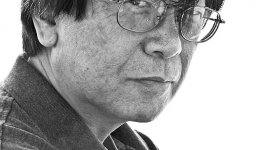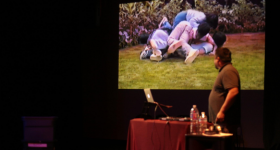There’s something about a woman with a blowtorch that grabs my attention. The bright rod of orange and blue flame reflected in protective glasses, the steady roar of gas, the occasional faint yet pugnacious whiff of sulfur—this artist evokes power and incandescent spirit like nothing else.
Kana Tanaka takes her blowtorching seriously. Her name is magical, a palindrome if you read it by syllable as they do in Japan. Tanaka was first introduced to molten glass as a college student in Aichi, Japan. Two years later, in 1994, she enrolled in the Masters of Fine Arts program at The Rhode Island School of Design, where she learned to apply her fascination with glass and light to her art. She moved to California in 2000, where she has let her discovery burst into a budding career as a performance artist.
Today, Tanaka works with glass, light and hot furnaces to create scenes of magnificent and measured beauty. Her largest and grandest work to date is her suspended sculpture in the entryway of the Solano County Government Center in Fairfield, CA. A lattice of steel cables emerges from a point on a wall high above the floor and projects as a triangular ray 40-feet long and 24-feet wide. The webbing supports over 1,500 glass balls, each somewhat larger than a Bocce ball, which Tanaka meticulously gathered out of a hot furnace, sculpted and drilled to fit the cable. The effect is that of morning dew on a cobweb, capturing the ample sunlight of day and the ring of incandescent lights hanging from the ceiling above. The installation weighs over 1,200 pounds, yet it appears airy and transcendent. Tanaka calls this visual translation of nature merging with light “of Capturing a Moment,” a moment of quiet beauty frozen in time.
But I promised you blowtorches. Tanaka uses her blowtorch to fire small glass beads that glow red-hot and leap toward the earth as they melt, trailing slender threads of glass that hold them in midair as they cool and solidify. She then hangs the suspended drops, which range from three to over 30 feet in length, on a thin cable above. The completed installation is a like a snapshot of raindrops caught in midair, shimmering in surreal light. I first saw one of her glass rain installations in 2004 when she was the featured artist at the Kearny Street Workshop’s APAture exhibit in San Francisco.
Tanaka’s work becomes intensely personal in the space where creator and viewer meet. I am at the Project Artaud Theater Gallery in San Francisco for “Shizuku – Drop III” (shizuku means “drop” in Japanese). For the first time, I am watching her wield her blowtorch live, creating drops in real time. Tanaka stands on a ladder, dressed in black except for the bright yellow gas cylinder blowtorch and funky didymium safety glasses. I’m mesmerized by her actions as she turns solid glass into liquid and back again. She reminds me of a bunraku puppeteer, pretending to be invisible as she manipulates forms.
Down below are three dancers from the MoBu Dance Company dressed in silver-blue gowns with interior hoop supports that widen as they bounce up and narrow as the gown reaches the floor. As they contort below like giant dewdrops, Tanaka comes down from the ladder and goes offstage, reappearing on a catwalk 30 feet above. From there, she drips strands of glass so long that some nearly graze the performers below.
The scene is alive, intensely furtive and fertile. The dancers step out of their gowns to reveal clingy, form-hugging skin toned camisole pantsuits that hang loosely about the legs. They melt and ripple out over the stage, responding to the pops and watery splats of the ethereal soundtrack.
As a coda, Kana puts down her blowtorch and blows soap bubbles with a plastic wand out of a Mr. Bubbles bottle, merging liquid and air to complete her creation using all states of matter. One bubble floats through the audience and pops near me. Suddenly, I’m part of the transformation as well.
Tanaka is fascinated by “trigger moments,” which occur when light transiently interacts with materials like glass and water.
“With glass, I take the experience of light and share it with others,” she says. “When I see the reflections of my pieces in my audience’s eyes, the communication process becomes complete.”
Ravi Chandra is a San Francisco-based writer and psychiatrist. Find out about Tanaka’s other work and upcoming shows at www.kanatanaka.com.









Comments